1. Summary
At the request of a Member of Provincial Parliament, this report reviews the Government of Ontario’s (the Province’s) Ministry of Children, Community and Social Services (MCCSS or ministry) spending plan as outlined in the 2025 Ontario Budget.
Spending Plan Overview
- In the 2025 Ontario Budget, the Province projects that MCCSS spending will decrease at an average annual rate of -0.5 per cent, from $20.7 billion in 2024-25 to $20.4 billion in 2027-28.
- This is a significantly slower pace than the 6.7 per cent average annual growth over the previous three years from 2021-22 to 2024-25.
- For context, over the 34-year period from 1990-91 to 2023-24, MCCSS spending grew at an average annual rate of 3.1 per cent. If the Province’s MCCSS spending plan in the 2025 budget is achieved, it would be the slowest three-year growth rate since 1999-00 to 2002-03.
- The FAO estimated the MCCSS spending from 2025-26 to 2027-28 that would be required to maintain 2024-25 service levels. Also known as a cost driver forecast, this scenario does not recommend how spending should change but serves as a benchmark to show whether the 2025 budget’s MCCSS spending plan is likely to maintain, improve or reduce the quality and accessibility of ministry services.
- Overall, the FAO estimates that MCCSS spending would need to grow by an average annual rate of 4.2 per cent over the next three years to maintain current service levels.
- The 2025 budget spending plan is below the FAO’s cost driver projection by $1.5 billion in 2025-26, $2.4 billion in 2026-27 and $3.1 billion in 2027-28. This means that the Province will need to implement significant program efficiencies (i.e., provide the same level of services with less resources) and/or commit additional funding to the ministry to maintain 2024-25 service levels.
Spending Plan Analysis: Ontario Disability Support Program
- The Ontario Disability Support Program (ODSP) – Financial Assistance provides direct financial assistance to Ontarians with disabilities and their families.
- In 2024-25, the average monthly number of ODSP cases was 372,681.[1] Going forward, the FAO estimates that the number of ODSP cases will increase at an average annual rate of 2.6 per cent, reaching 402,639 ODSP cases in 2027-28.
- In 2024-25, the average annual ODSP allowance was $15,891. Based on prescribed increases in allowances, the FAO projects that the average inflation-adjusted (i.e., real) allowance will reach $16,073 in 2027-28.
- Based on projected increases in ODSP cases and prescribed increases in allowances, the FAO estimates that total ODSP spending will increase from $6.2 billion in 2024-25 to $7.2 billion in 2027-28. This increase in spending is higher than the funding allocated to the ODSP in the 2025 budget.
Spending Plan Analysis: Ontario Works
- The Ontario Works (OW) – Financial Assistance program provides direct financial assistance to Ontarians facing barriers to employment.
- In 2024-25, there were 282,011 average monthly Ontario Works cases.[2] Going forward, the FAO projects that OW cases will increase at an average annual rate of 5.5 per cent, reaching 330,684 OW cases in 2027-28.
- In 2024-25, the average annual OW allowance was $9,455. As OW allowance rates are currently frozen, the FAO estimates that the average inflation-adjusted (i.e., real) allowance will decline to $8,891 in 2027-28.
- Based on projected increases in OW cases and assuming no change in allowance rates, the FAO estimates that total OW program spending will increase from $3.3 billion in 2024-25 to $3.7 billion in 2027-28. This increase in spending is higher than the funding allocated to the OW program in the 2025 budget.
Interprovincial Comparison: Social Assistance
- Social assistance refers to direct payments provided by provincial governments to eligible recipients, which in Ontario includes Ontario Works and the Ontario Disability Support Program.
- In 2023, Ontario ranked fourth highest in average annual per recipient[3] social assistance payments, at $11,264, after adjusting for price differences across provinces. This was $193 above the national average of $11,071. Compared to other large provinces, Ontario’s average annual per recipient social assistance payments were lower than in Alberta ($12,227) and Quebec ($11,603) but higher than in British Columbia ($9,495).
- In 2023, Ontario had the fifth lowest proportion of social assistance recipients relative to total provincial population aged 15 and over, at 5.3 per cent. This was 0.2 percentage points above the Canadian average of 5.1 per cent. This was also above Alberta (4.9 per cent) and Quebec (4.1 per cent) but below British Columbia (6.4 per cent).
2. Introduction
This report reviews the Government of Ontario’s (the Province’s) Ministry of Children, Community and Social Services (MCCSS or ministry) spending plan as outlined in the 2025 Ontario Budget.
This analysis was undertaken in response to a request from a Member of Provincial Parliament and is part of a planned series that reviews the spending plans for five ministries: Health; Long-Term Care; Education; Colleges, Universities, Research Excellence and Security; and Children, Community and Social Services.
The report is organized as follows:
- Chapter 3 reviews the Province’s MCCSS spending plan in the 2025 Ontario Budget against both historical MCCSS spending and estimated ministry cost drivers. The cost driver analysis includes the FAO’s projection for MCCSS spending required to maintain current service levels.
- Chapter 4 estimates Ontario Disability Support Program and Ontario Works cases, benefit rates and total spending, given current program rules.
- Chapter 5 provides an interprovincial comparison of spending on social assistance.
For additional information on the Ministry of Children, Community and Social Services’ 2025-26 spending plan, see the FAO’s Examining Ontario’s 2025-26 Expenditure Estimates, which compares planned spending against actual spending over the previous four years to the standard account level of detail.
3. Spending Plan Overview
In the 2025 Ontario Budget, the Province projects that MCCSS spending will decline at an average annual rate of -0.5 per cent, from $20.7 billion in 2024-25 to $20.4 billion in 2027-28. This is a significantly slower pace than the 6.7 per cent average annual growth over the previous three years from 2021-22 to 2024-25.
Figure 3.1 Ministry of Children, Community and Social Services spending plan in the 2025 Ontario Budget
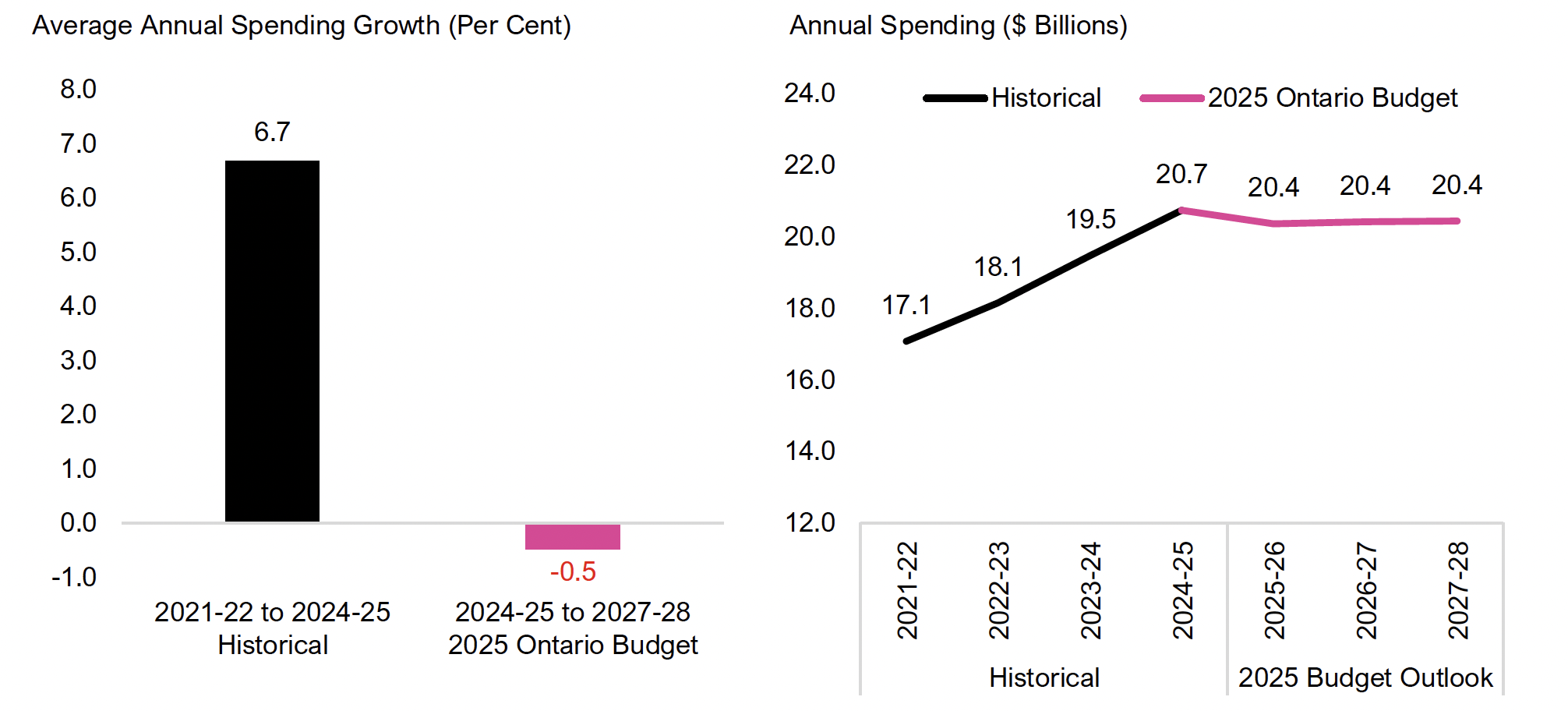
Note: Historical values are not restated for program transfers or reclassifications, if any.
Source: Ontario Public Accounts, the 2025 Ontario Budget and FAO analysis.
Accessible version
Average Annual Spending Growth (Per Cent)
| 2021-22 to 2024-25 Historical |
2024-25 to 2027-28 2025 Ontario Budget |
|---|---|
| 6.7 | -0.5 |
Annual Spending ($ Billions)
| Historical | 2025 Ontario Budget | ||
|---|---|---|---|
| Historical | 2021-22 | 17.1 | |
| Historical | 2022-23 | 18.1 | |
| Historical | 2023-24 | 19.5 | |
| Historical | 2024-25 | 20.7 | |
| 2025 Budget Outlook | 2025-26 | 20.4 | |
| 2025 Budget Outlook | 2026-27 | 20.4 | |
| 2025 Budget Outlook | 2027-28 | 20.4 |
For context, over the 34-year period from 1990-91 to 2023-24, MCCSS spending grew at an average annual rate of 3.1 per cent.[4] The Province’s MCCSS spending plan in the 2025 budget calls for significantly slower spending growth compared to the 34-year average and would be the slowest three-year growth rate since 1999-00 to 2002-03.
Spending Plan Compared to Cost Drivers
At the request of the Member of Provincial Parliament, the FAO estimated MCCSS spending over the next three years that would be required to maintain 2024-25 service levels. Also known as a cost driver forecast, this scenario does not recommend how spending should change but serves as a benchmark to show whether the 2025 budget’s MCCSS spending plan is likely to maintain, improve or reduce the quality and accessibility of ministry services.
Overall, the FAO estimates that MCCSS spending would need to grow by an average annual rate of 4.2 per cent over the next three years to maintain current ministry service levels. The components of the FAO’s cost driver forecast vary by program area:[5]
- Ontario Disability Support Program (ODSP): The FAO estimates that ODSP spending would need to grow by an average annual rate of 4.9 per cent over the next three years to maintain service levels. This estimate is based on projected population growth and aging, as ODSP utilization tends to increase with age but declines at the age of 65 when people are eligible for federal Old Age Security (OAS) payments, and inflation.
- Ontario Works (OW): The FAO estimates that OW spending would need to grow by an average annual rate of 6.3 per cent over the next three years to maintain service levels. This estimate is based on the FAO’s forecast for unemployment, which contributes to OW utilization, and inflation.
- Ontario Drug Benefit Plan (ODBP): The FAO estimates that ODBP spending would need to grow by an average annual rate of 7.4 per cent over the next three years to maintain service levels. This estimate is based on the FAO’s forecast for ODSP and OW cases, which are the primary recipients of the ODBP, and drug price inflation.
- Ontario Child Benefit (OCB): The FAO estimates that OCB spending would need to grow by an average annual rate of 2.2 per cent over the next three years to maintain service levels. This estimate is based on the FAO’s forecast for the population of children aged 0 to 17 years in Ontario and inflation.
- All other ministry programs: The FAO estimates that spending on all other ministry programs would need to grow by an average annual rate of 2.9 per cent over the next three years to maintain service levels. This estimate is based on population growth and inflation.
Figure 3.2 Comparing Ministry of Children, Community and Social Services spending growth, FAO cost driver forecast vs. 2025 Ontario Budget, 2024-25 to 2027-28
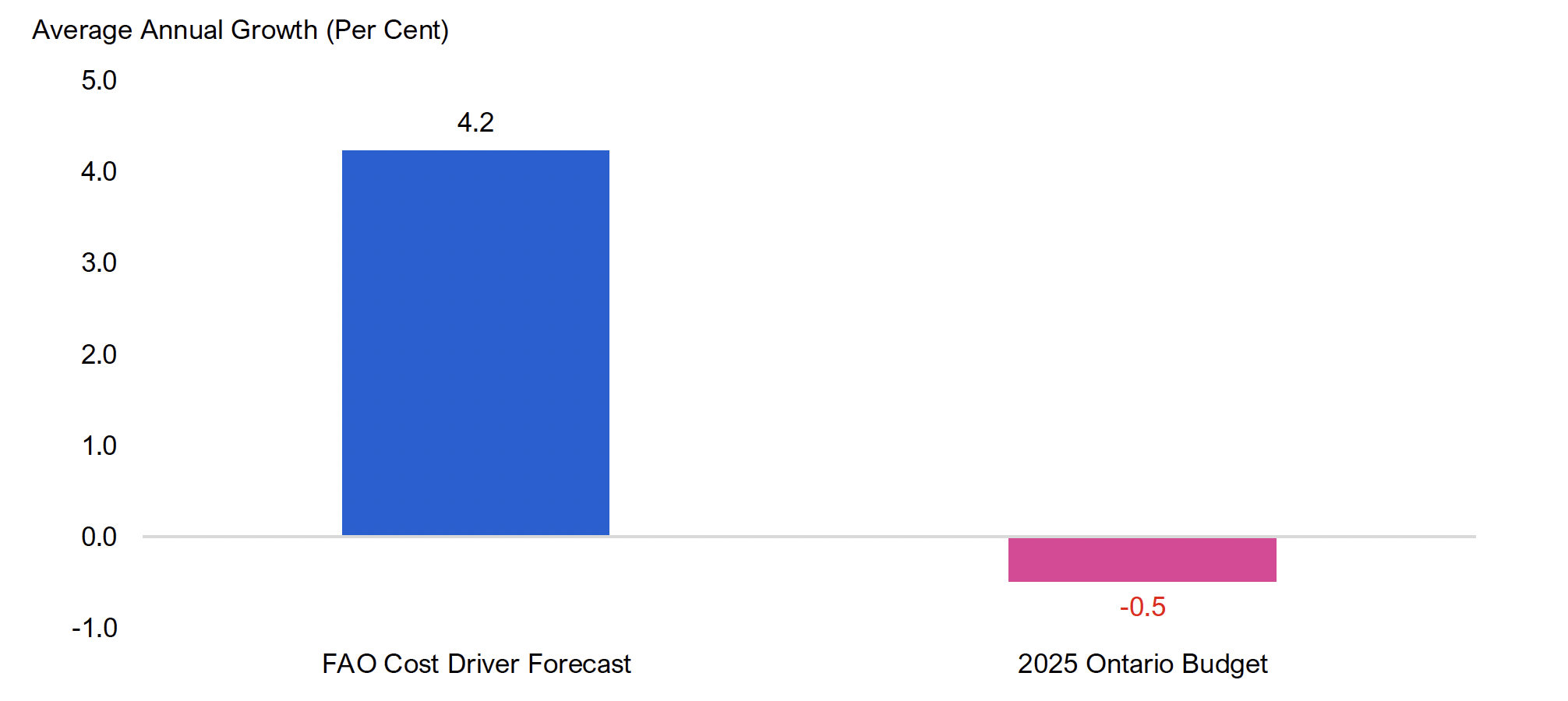
Source: 2024-25 Public Accounts of Ontario, 2025 Ontario Budget and FAO analysis.
Accessible version
Average Annual Spending Growth (Per Cent)
| FAO Cost Driver Forecast | 2025 Ontario Budget |
|---|---|
| 4.2 | -0.5 |
As noted above, in the 2025 budget, the Province projects that MCCSS spending will decline at an average annual rate of -0.5 per cent from 2024-25 to 2027-28. Compared to the FAO’s cost driver projection, this results in a funding shortfall of $1.5 billion in 2025-26, $2.4 billion in 2026-27 and $3.1 billion in 2027-28.
Figure 3.3 FAO cost driver projection and the Ministry of Children, Community and Social Services spending plan in the 2025 Ontario Budget
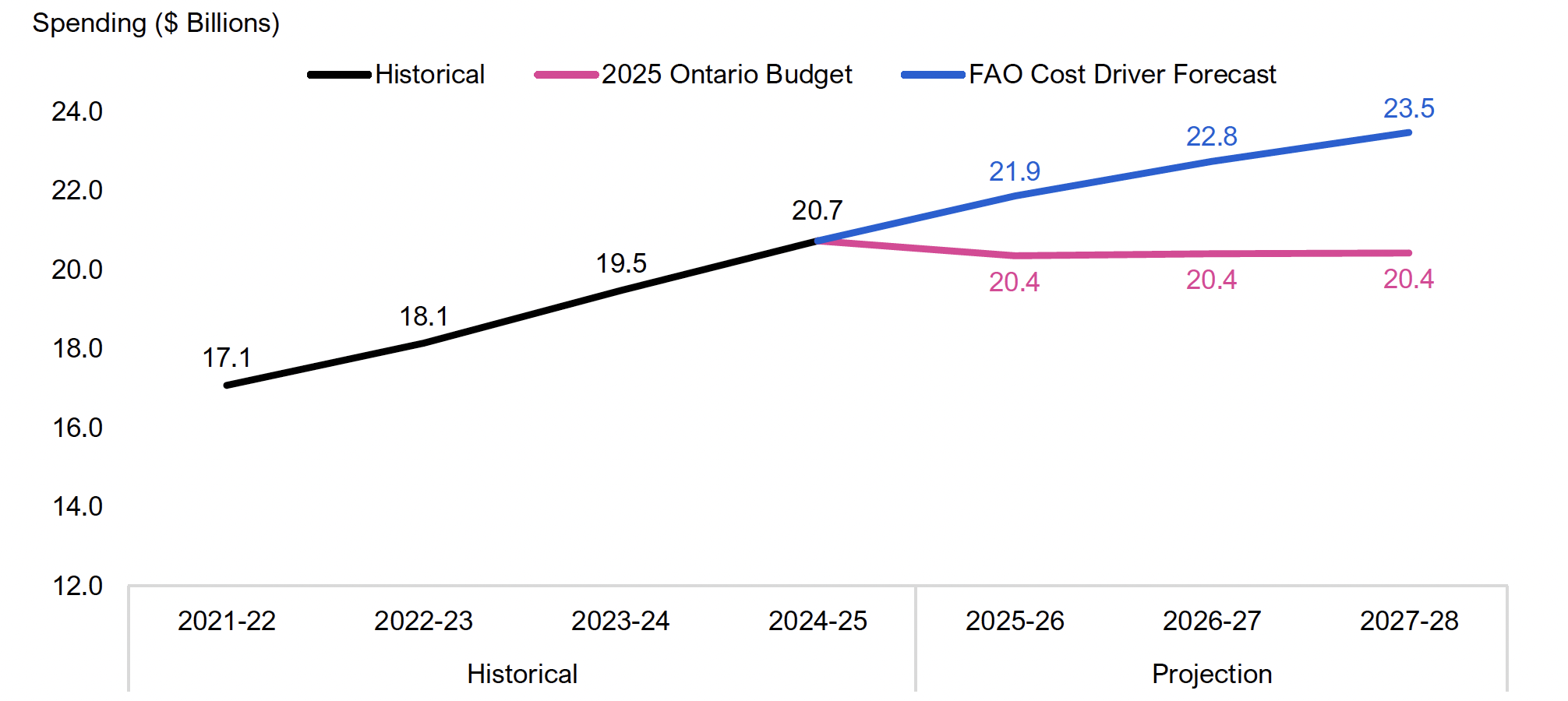
Note: Historical values are not restated for program transfers or reclassifications, if any.
Source: Ontario Public Accounts, 2025 Ontario Budget and FAO analysis.
Accessible version
Spending ($ Billions)
| Historical | FAO Cost Driver Forecast | 2025 Ontario Budget | ||
|---|---|---|---|---|
| Historical | 2021-22 | 17.1 | ||
| Historical | 2022-23 | 18.1 | ||
| Historical | 2023-24 | 19.5 | ||
| Historical | 2024-25 | 20.7 | ||
| Projection | 2025-26 | 21.9 | 20.4 | |
| Projection | 2026-27 | 22.8 | 20.4 | |
| Projection | 2027-28 | 23.5 | 20.4 |
The funding shortfall means that, in order to maintain current service levels, the Province will need to implement significant MCCSS efficiencies (i.e., provide the same level of services with less resources) and/or commit additional funding beyond what was planned in the 2025 Ontario Budget.
4. Spending Plan Analysis
At the request of the Member of Provincial Parliament, the FAO projected Ontario Disability Support Program and Ontario Works cases, benefit rates and total spending, given current program rules.
Ontario Disability Support Program – Financial Assistance
The Ontario Disability Support Program (ODSP) – Financial Assistance provides direct financial assistance to Ontarians with disabilities and their families. In 2024-25, the average monthly number of ODSP cases was 372,681.[6] Going forward, the FAO estimates that the number of ODSP cases will increase at an average annual rate of 2.6 per cent, reaching 386,306 cases in 2025-26 and 402,639 ODSP cases in 2027-28. This estimate is based on the FAO’s projection of population growth and aging,[7] and a return to pre-pandemic utilization rates.[8]
Figure 4.1 Average monthly Ontario Disability Support Program cases, 2015-16 to 2027-28
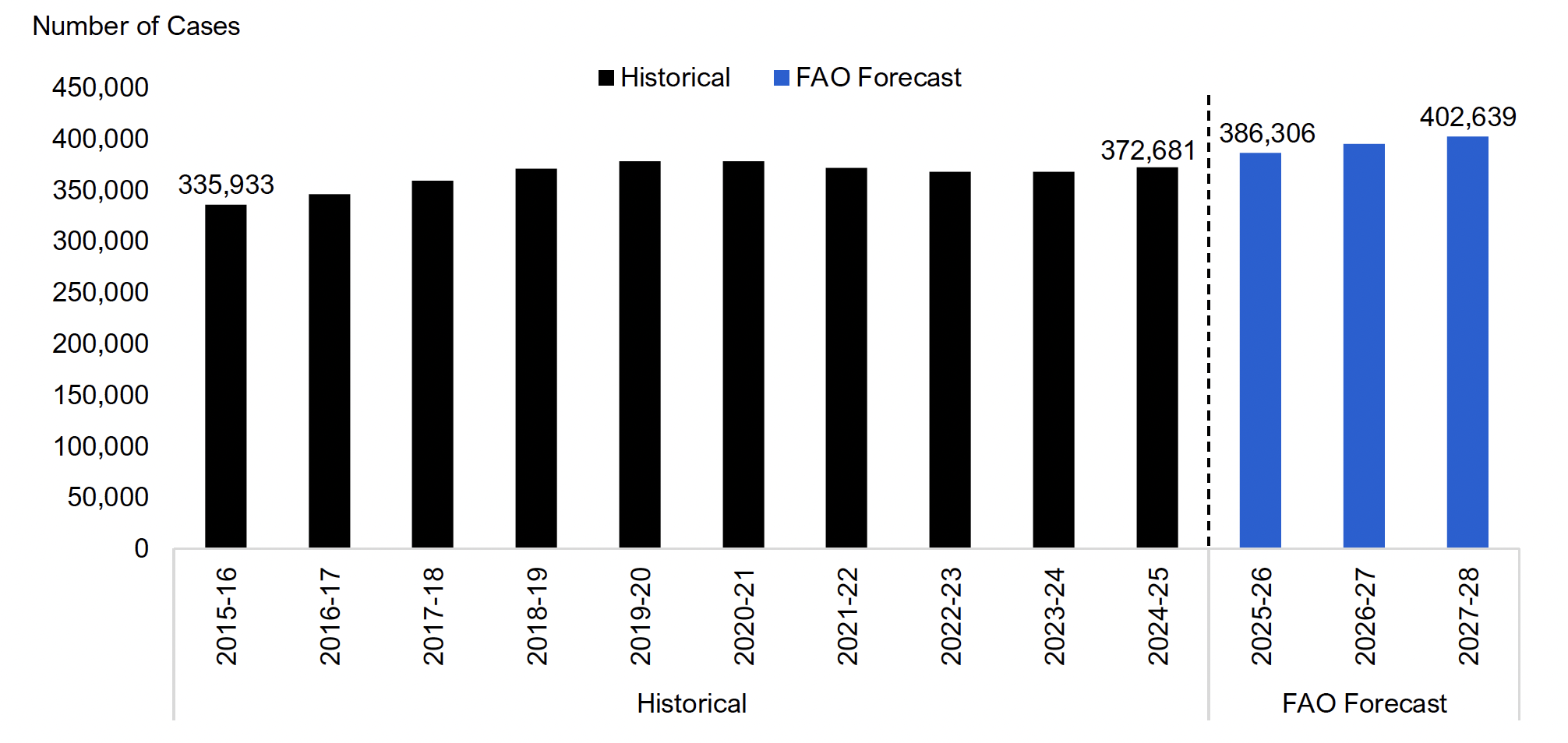
Note: One case refers to a single individual or family unit on ODSP. Excludes Assistance for Children with Severe Disabilities cases.
Source: Government of Ontario Open Data: Social Assistance Caseload and FAO analysis.
Accessible version
Number of Cases
| Historical | FAO Forecast | ||
|---|---|---|---|
| Historical | 2015-16 | 335,933 | |
| Historical | 2016-17 | 346,070 | |
| Historical | 2017-18 | 359,330 | |
| Historical | 2018-19 | 370,674 | |
| Historical | 2019-20 | 378,441 | |
| Historical | 2020-21 | 378,145 | |
| Historical | 2021-22 | 371,462 | |
| Historical | 2022-23 | 367,828 | |
| Historical | 2023-24 | 368,052 | |
| Historical | 2024-25 | 372,681 | |
| FAO Forecast | 2025-26 | 386,306 | |
| FAO Forecast | 2026-27 | 395,456 | |
| FAO Forecast | 2027-28 | 402,639 |
In 2024-25, the FAO estimates that the average annual ODSP allowance was $15,891.[9] The FAO projects the inflation-adjusted (i.e., real) allowance rate will remain relatively constant, reaching $16,073 in 2027-28, as ODSP allowances are mandated to increase annually by the inflation observed in the 12-month period ending on September 30 of the previous year.[10]
Figure 4.2 Average annual Ontario Disability Support Program allowance, inflation-adjusted, 2015-16 to 2027-28
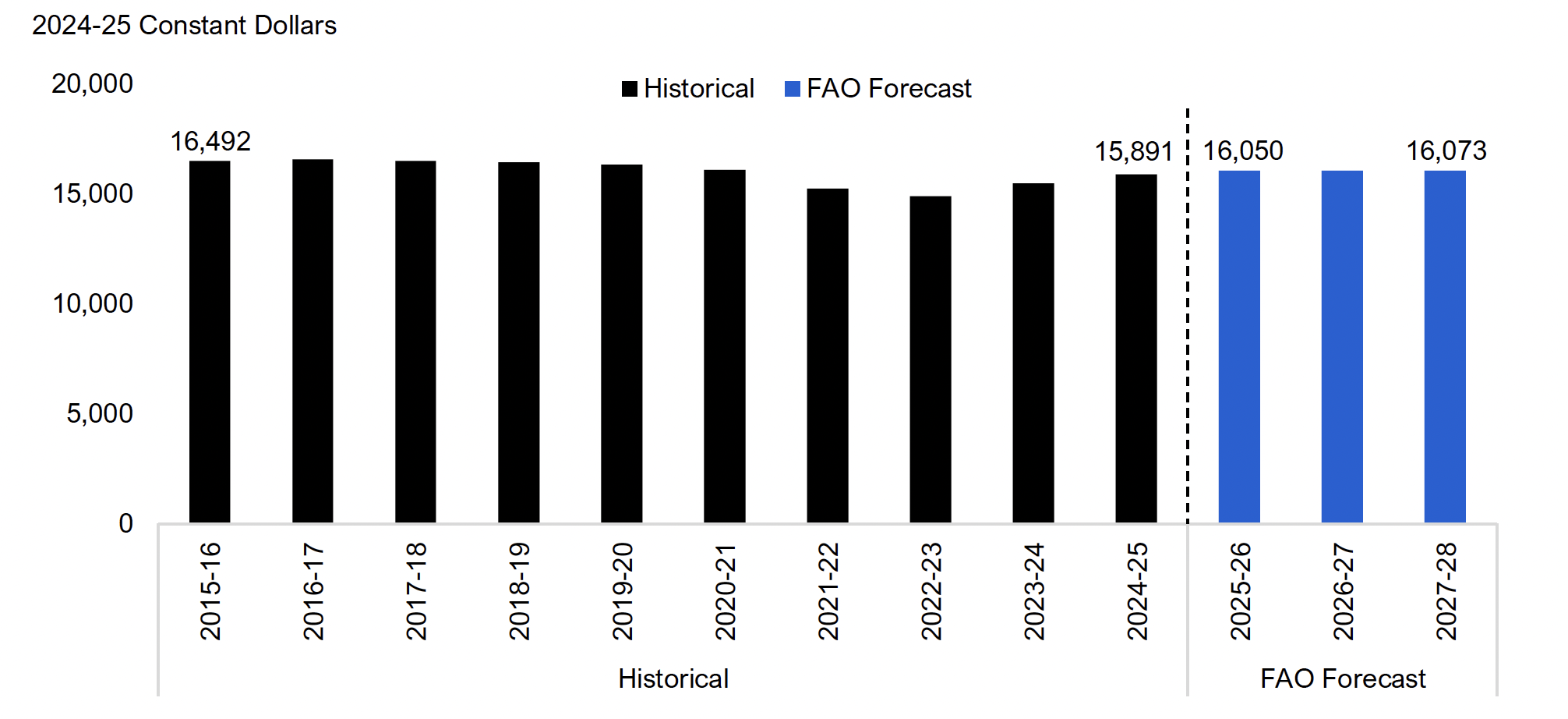
Note: The average annual ODSP allowance per case excludes payments for Assistance for Children with Severe Disabilities.
Source: Ontario Public Accounts, 2025 Ontario Budget and FAO analysis.
Accessible version
2024-25 Constant Dollars
| Historical | FAO Forecast | ||
|---|---|---|---|
| Historical | 2015-16 | 16,492 | |
| Historical | 2016-17 | 16,563 | |
| Historical | 2017-18 | 16,510 | |
| Historical | 2018-19 | 16,441 | |
| Historical | 2019-20 | 16,341 | |
| Historical | 2020-21 | 16,103 | |
| Historical | 2021-22 | 15,245 | |
| Historical | 2022-23 | 14,908 | |
| Historical | 2023-24 | 15,493 | |
| Historical | 2024-25 | 15,891 | |
| FAO Forecast | 2025-26 | 16,050 | |
| FAO Forecast | 2026-27 | 16,049 | |
| FAO Forecast | 2027-28 | 16,073 |
Based on projected increases in ODSP cases and prescribed increases in allowances, the FAO estimates that ODSP spending will increase from $6.2 billion in 2024-25 to $7.2 billion in 2027-28. This increase in spending is higher than the funding allocated to the ODSP in the 2025 budget.[11]
Figure 4.3 Annual Ontario Disability Support Program spending, 2015-16 to 2027-28

Source: Ontario Public Accounts, 2025 Ontario Budget and FAO analysis.
Accessible version
Annual Spending ($ Billions)
| Historical | FAO Forecast | ||
|---|---|---|---|
| Historical | 2015-16 | 4.6 | |
| Historical | 2016-17 | 4.8 | |
| Historical | 2017-18 | 5.1 | |
| Historical | 2018-19 | 5.3 | |
| Historical | 2019-20 | 5.5 | |
| Historical | 2020-21 | 5.4 | |
| Historical | 2021-22 | 5.3 | |
| Historical | 2022-23 | 5.5 | |
| Historical | 2023-24 | 5.9 | |
| Historical | 2024-25 | 6.2 | |
| FAO Forecast | 2025-26 | 6.7 | |
| FAO Forecast | 2026-27 | 7.0 | |
| FAO Forecast | 2027-28 | 7.2 |
Ontario Works – Financial Assistance
The Ontario Works (OW) – Financial Assistance program provides direct financial assistance to Ontarians facing barriers to employment. In 2024-25, there were 282,011 average monthly Ontario Works cases.[12] Going forward, the FAO projects that OW cases will increase at an average annual rate of 5.5 per cent to 330,684 in 2027-28, based on the FAO’s forecast for unemployment in Ontario, which contributes to OW utilization.[13]
Figure 4.4 Average monthly Ontario Works cases, 2015-16 to 2027-28
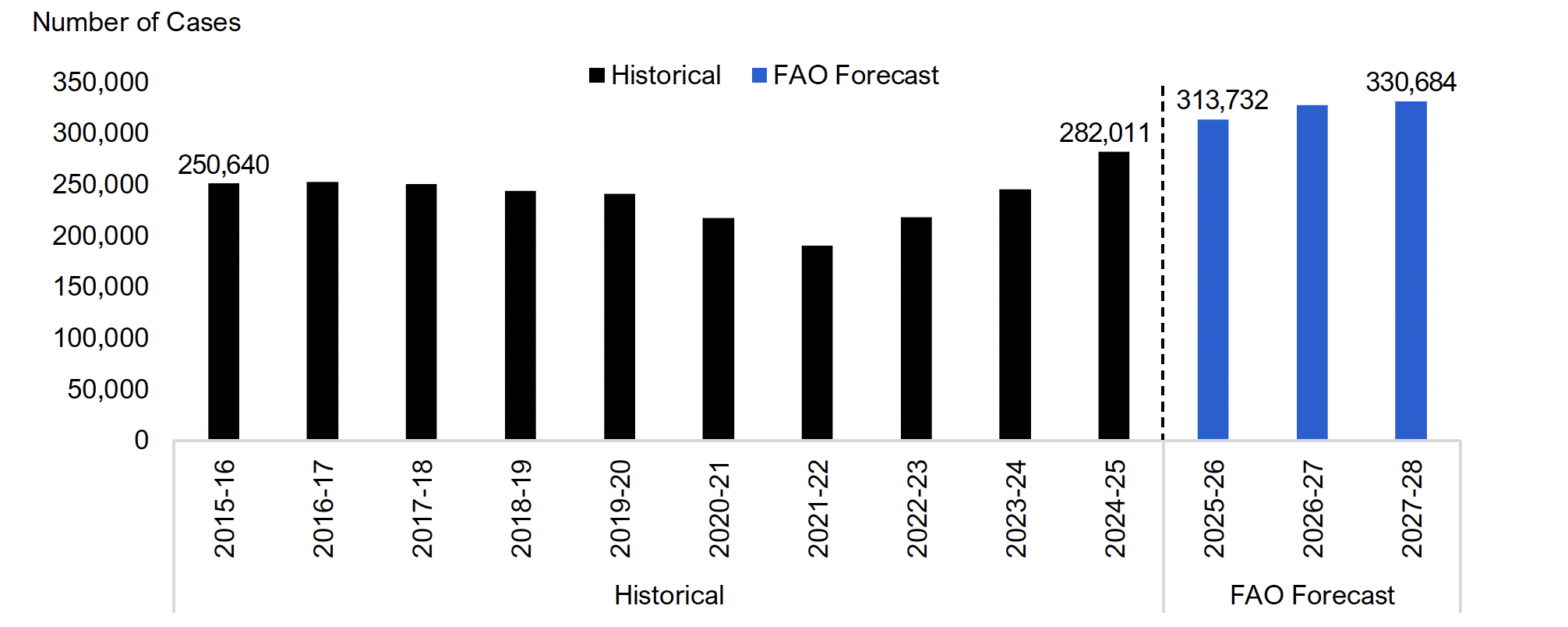
Note: One case refers to a single individual or family unit on OW. Excludes Temporary Care Assistance cases.
Source: Government of Ontario Open Data: Social Assistance Caseload and FAO analysis.
Accessible version
Number of Cases
| Historical | FAO Forecast | ||
|---|---|---|---|
| Historical | 2015-16 | 250,640 | |
| Historical | 2016-17 | 252,247 | |
| Historical | 2017-18 | 250,292 | |
| Historical | 2018-19 | 243,875 | |
| Historical | 2019-20 | 240,545 | |
| Historical | 2020-21 | 217,234 | |
| Historical | 2021-22 | 189,981 | |
| Historical | 2022-23 | 217,639 | |
| Historical | 2023-24 | 245,246 | |
| Historical | 2024-25 | 282,011 | |
| FAO Forecast | 2025-26 | 313,732 | |
| FAO Forecast | 2026-27 | 327,241 | |
| FAO Forecast | 2027-28 | 330,684 |
In 2024-25, the average annual OW allowance was $9,455.[14] As OW allowance rates are currently frozen, the FAO estimates that the average inflation-adjusted (i.e., real) OW allowance will decline to $8,891 in 2027-28.
Figure 4.5 Average annual Ontario Works allowances, inflation-adjusted, 2015-16 to 2027-28

Note: The average annual OW allowance per case excludes payments for Temporary Care Assistance.
Source: Ontario Public Accounts, 2025 Ontario Budget and FAO analysis.
Accessible version
2024-25 Constant Dollars
| Historical | FAO Forecast | ||
|---|---|---|---|
| Historical | 2015-16 | 11,500 | |
| Historical | 2016-17 | 11,127 | |
| Historical | 2017-18 | 11,039 | |
| Historical | 2018-19 | 11,408 | |
| Historical | 2019-20 | 11,299 | |
| Historical | 2020-21 | 11,305 | |
| Historical | 2021-22 | 10,409 | |
| Historical | 2022-23 | 10,107 | |
| Historical | 2023-24 | 9,833 | |
| Historical | 2024-25 | 9,455 | |
| FAO Forecast | 2025-26 | 9,258 | |
| FAO Forecast | 2026-27 | 9,067 | |
| FAO Forecast | 2027-28 | 8,891 |
Based on projected increases in OW cases and assuming no change in allowance rates, the FAO estimates that OW program spending will increase from $3.3 billion in 2024-25 to $3.7 billion in 2027-28. This increase in spending is higher than the funding allocated to the OW program in the 2025 budget.[15]
Figure 4.6 Annual Ontario Works program spending, 2015-16 to 2027-28
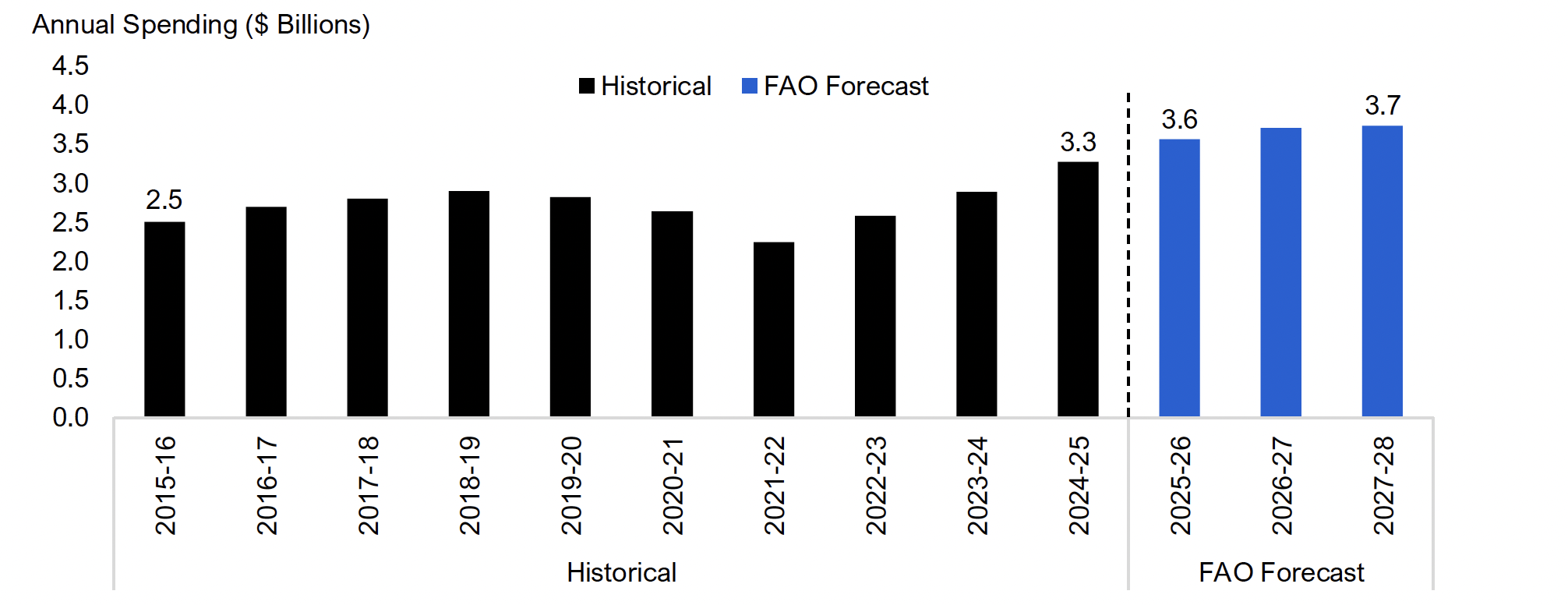
Source: Ontario Public Accounts, 2025 Ontario Budget and FAO analysis.
Accessible version
Annual Spending ($ Billions)
| Historical | FAO Forecast | ||
|---|---|---|---|
| Historical | 2015-16 | 2.5 | |
| Historical | 2016-17 | 2.7 | |
| Historical | 2017-18 | 2.8 | |
| Historical | 2018-19 | 2.9 | |
| Historical | 2019-20 | 2.8 | |
| Historical | 2020-21 | 2.6 | |
| Historical | 2021-22 | 2.2 | |
| Historical | 2022-23 | 2.6 | |
| Historical | 2023-24 | 2.9 | |
| Historical | 2024-25 | 3.3 | |
| FAO Forecast | 2025-26 | 3.6 | |
| FAO Forecast | 2026-27 | 3.7 | |
| FAO Forecast | 2027-28 | 3.7 |
5. Interprovincial Comparison
At the request of the Member of Provincial Parliament, this chapter compares Ontario’s social assistance payments with the other provinces.
Social Assistance Payments
Social assistance refers to direct payments provided by provincial governments to eligible recipients, which in Ontario includes Ontario Works and the Ontario Disability Support Program.[16] In 2023, Ontario ranked fourth highest in average annual per recipient[17] social assistance payments at $11,264, after adjusting for price differences across provinces.[18] Ontario’s average annual per recipient social assistance payments were $193 higher than the Canadian average of $11,071. Compared to other large provinces, Ontario’s average annual per recipient social assistance payments were lower than in Alberta ($12,227) and Quebec ($11,603) but higher than in British Columbia ($9,495).
Figure 5.1 Average annual social assistance payments per recipient by province, adjusted for provincial price differences, 2023
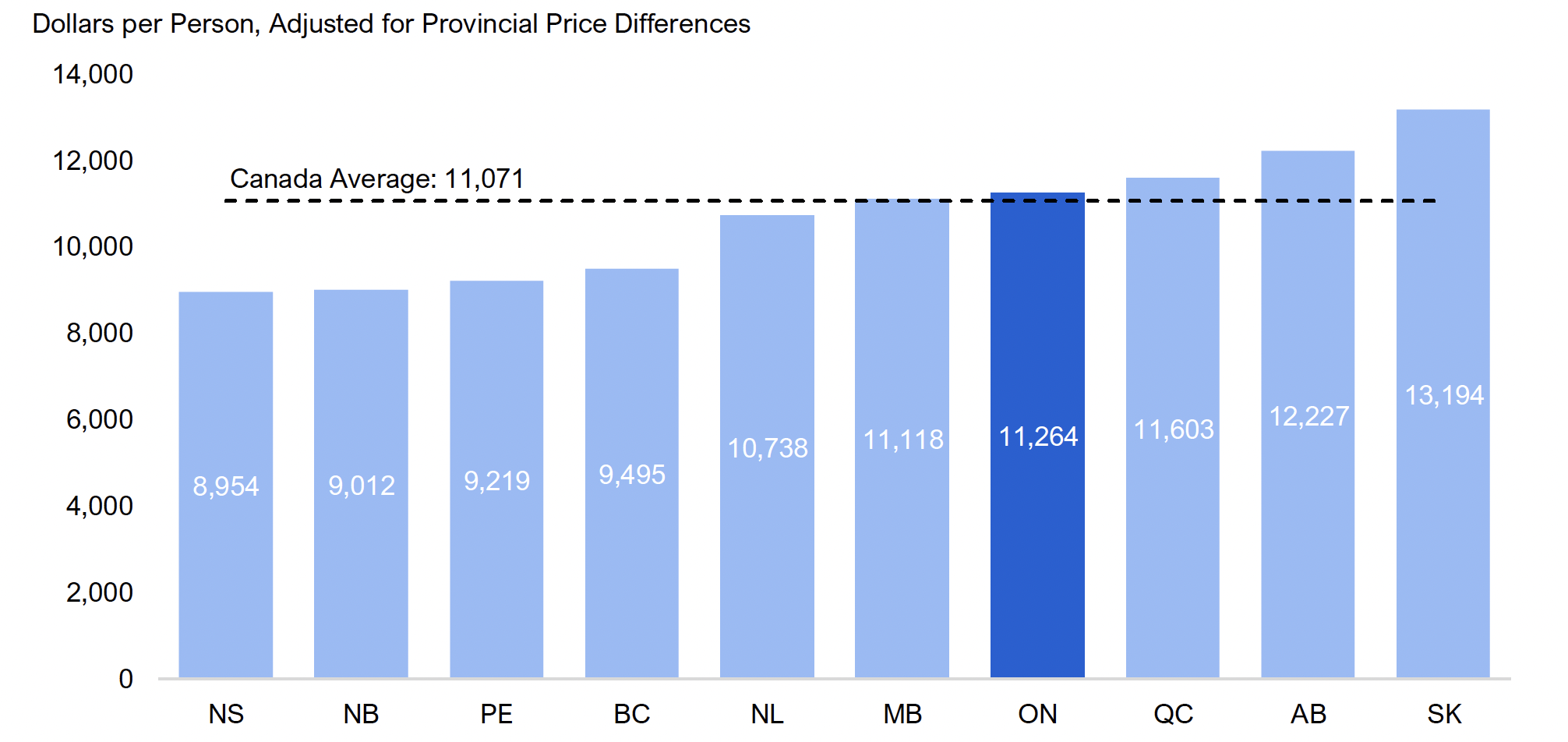
Note: Social assistance payments are adjusted for provincial differences in prices, using purchase power parity indices, to provide a comparison of the purchasing power of social assistance payments (i.e., the amount of shelter, food, clothing and other goods/services that each province’s social assistance benefits could purchase). Canada average excludes territories.
Source: Statistics Canada Canadian Income Survey (2023), Purchasing Power Parities for Consumption and Household Income Across the Canadian Provinces and Territories, and FAO.
Accessible version
Dollars per Person, Adjusted for Provincial Price Differences
| Province | Average annual social assistance payments per recipient |
|---|---|
| NS | 8,954 |
| NB | 9,012 |
| PE | 9,219 |
| BC | 9,495 |
| NL | 10,738 |
| MB | 11,118 |
| ON | 11,264 |
| QC | 11,603 |
| AB | 12,227 |
| SK | 13,194 |
| Canada Average | 11,071 |
Social Assistance Recipient Share
In 2023, Ontario had the fifth lowest proportion of social assistance recipients relative to total provincial population aged 15 and over, at 5.3 per cent. This was 0.2 percentage points above the Canadian average of 5.1 per cent. This was also above Alberta (4.9 per cent) and Quebec (4.1 per cent) but below British Columbia (6.4 per cent).
Figure 5.2 Social assistance recipients as a share of population aged 15 and over by province, 2023
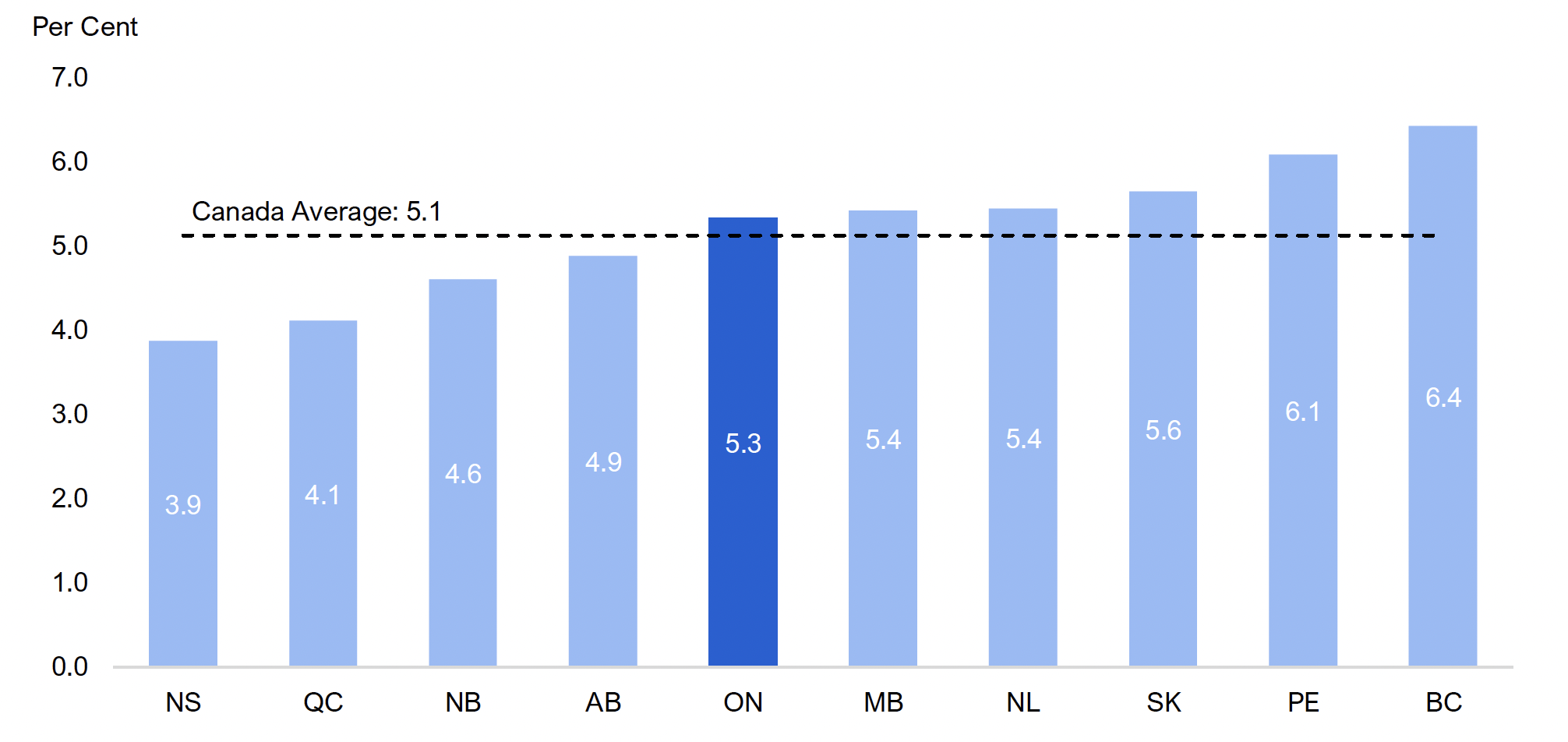
Note: Canada average excludes territories.
Source: Statistics Canada Canadian Income Survey (2023) and FAO.
Accessible version
Per Cent
| Province | Social assistance recipients as a share of population 15 and over |
|---|---|
| NS | 3.9 |
| QC | 4.1 |
| NB | 4.6 |
| AB | 4.9 |
| ON | 5.3 |
| MB | 5.4 |
| NL | 5.4 |
| SK | 5.6 |
| PE | 6.1 |
| BC | 6.4 |
| Canada Average | 5.1 |
Footnotes
[1] One case refers to a single individual or family unit on ODSP. Excludes Assistance for Children with Severe Disabilities cases.
[2] One case refers to a single individual or family unit on OW. Excludes Temporary Care Assistance cases.
[3] A recipient is an individual aged 15 and over who reported receiving social assistance income in Statistics Canada’s Canadian Income Survey.
[4] FAO, Government Spending Trends: 1990 to 2023.
[5] For more information on MCCSS program areas, see FAO, Ministry of Children, Community and Social Services: Spending Plan Review.
[6] One case refers to a single individual or family unit on ODSP. Excludes Assistance for Children with Severe Disabilities cases.
[7] ODSP utilization peaks in the 45-64 age group and drops off above 65 as Ontarians are eligible for federal Old Age Security (OAS) payments.
[8] The ODSP experienced a dip in cases during the pandemic due to several factors including reduced eligibility due to temporary federal COVID-19 income supports and reduced OW referrals. Bouck et al. (2024). Effects of the COVID-19 pandemic on the number and characteristics of public drug program beneficiaries in Ontario, Canada. Canadian Health Policy, July 2024.
[9] The average annual ODSP allowance per case excludes payments for Assistance for Children with Severe Disabilities.
[10] Ontario Regulation 2/23 made under the Ontario Disability Support Program Act, 1997.
[11] Under s. 13 of the Financial Accountability Officer Act, 2013 and s. 2(f) of order-in-council 404/2025, the FAO cannot disclose the ODSP spending plan in the 2025 budget.
[12] One case refers to a single individual or family unit on OW. Excludes Temporary Care Assistance cases.
[13] For more information on the FAO’s forecast of Ontario unemployment, see FAO, Economic and Budget Outlook, Summer 2025.
[14] The average annual OW allowance per case excludes payments for Temporary Care Assistance.
[15] Under s. 13 of the Financial Accountability Officer Act, 2013 and s. 2(f) of order-in-council 404/2025, the FAO cannot disclose the OW spending plan in the 2025 budget.
[16] Social assistance payments exclude in-kind supports, such as subsidized or co-op housing, employment supports, or subsidized job training.
[17] A recipient is an individual aged 15 and over who reported receiving social assistance income in Statistics Canada’s Canadian Income Survey.
[18] The FAO adjusted social assistance payments for provincial differences in prices, using purchase power parity indices, to provide a comparison of the purchasing power of social assistance payments (i.e., the amount of shelter, food, clothing and other goods/services that each province’s social assistance benefits could purchase). Purchasing power parity indices are from Statistics Canada, Purchasing Power Parities for Consumption and Household Income Across the Canadian Provinces and Territories.

